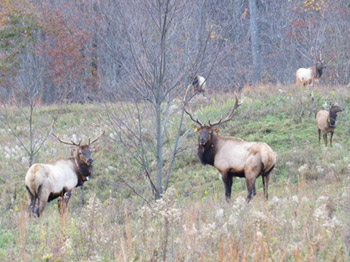
Feeding wildlife, particularly herd animals such as elk, can have serious negative consequences for the health of the population. Supplemental feeding of herd animals artificially concentrates animals in a small area, increases opportunity for disease transmission, and reduces their natural fear of humans.
It is illegal to distribute food, salt, or minerals to feed or attract deer or elk year-round in Wise, Dickenson, and Buchanan Counties, as well as in the counties (including the cities and towns within) listed on this page.
In the remainder of the state, it is illegal to place or distribute food, salt, or minerals to feed or attract deer or elk from September 1 through the first Saturday in January. It is also illegal to put out these substances to attract deer or elk during any deer or elk season within any county, city, or town that allows deer or elk hunting. This prohibition does not include the planting of agronomic crops or wildlife food plots.
Population Increase and Habitat Impacts
Regular feeding or baiting of elk can increase a population beyond the habitat’s normal carrying capacity. The artificial population increase can lead to habitat damage, including over browsing of vegetation and suppression of plant regeneration. Heavy browse damage caused by elk can lead to negative impacts on both habitat and other wildlife species using the area. Also, exotic plants that are less preferred by elk may eventually out-compete more valuable native plant species that elk prefer.
Behavior
Feeding elk can cause abnormal behaviors that put them and/or humans at risk. Risks include:
- Increased vehicle collisions when elk are fed from vehicles or cross roads traveling to feeding locations.
- Increased elk movement to and from feeding areas and sheltered areas where they spend cold winter nights. This extra movement can use up more energy than the elk get from the feed and have negative health effects.
- Conflict with pets/livestock can occur when elk become accustomed to seeking food associated with humans.
- Feeding can directly kill elk; no disease or toxins necessary. Feed such as corn is not readily digestible to elk until after their bodies have become accustomed to it. In the meantime the extra feed can fatally alter their internal chemistry. The elk, unaware of this, will continue to eat food that is killing them. Pennsylvania has recorded cases of otherwise healthy adult elk being killed by winter feeding
- Attacking humans when habituated elk accustomed to receiving food become highly aggressive when food is then withheld.
Disease
Concentrating wildlife around an artificial food source amplifies disease transmission. Of particular concern:
- Brucellosis
- Artificial feeding grounds have been proven to be epicenters of brucellosis outbreaks in western states. Elk that become exposed to brucellosis at feed piles can infect cattle.
- Bovine tuberculosis
- The practice of hunting over bait has significantly contributed to the high prevalence of bovine tuberculosis in white-tailed deer in the lower portion of the Upper Peninsula of Michigan. Spillover into livestock has occurred, resulting in tens of millions of dollars spent by both the Michigan Department of Agriculture and the Michigan Department of Natural Resources to manage bovine tuberculosis. Six elk have tested positive for bovine tuberculosis thus far in Michigan.
- Chronic wasting disease
- Invariably fatal, this degenerative brain disease has been diagnosed in twenty-three states and two Canadian provinces, including Virginia. Chronic wasting disease is spread through saliva, urine, and feces, and can remain active and infective for years in the environment. Concentrating elk or deer at a feeding site where even one animal is infected exposes every other deer or elk that visits the site to the disease agent.
Feeding or baiting can unintentionally expose elk to toxic substances. Of particular concern:
- Alflatoxin
- A toxin produced by a fungus which causes death or severe sudden illness in exposed animals. Birds are particularly sensitive to aflatoxin, but elk and deer may also become ill when exposed. Alflatoxin most commonly shows up in feed that is wet or moldy, and some feedstuff that is deemed unsuitable for livestock is re-packaged for use in wildlife due to a lack of regulatory oversight of feeds marketed for wildlife.
Get more information disease surveillance of Virginia’s elk.

